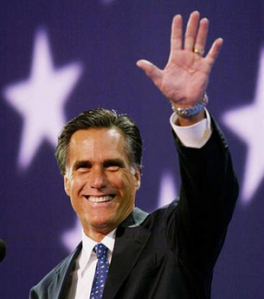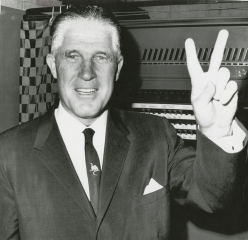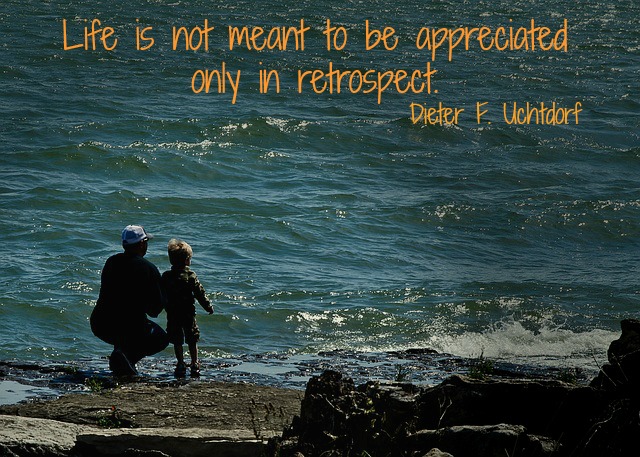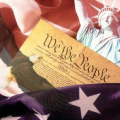Media have come a long way from the printing press in the 1400s to the instant electronic messages that we send today. The advances made in the past half-century alone are incredible! My children will never know a time without cell phones. At 13 and 11, my oldest two are still aghast that they don’t have one. They think they need a smartphone and an iPad. They tell me that they are the only kids who don’t have a cell phone, or an iPod or some other electronic gadget. They forget I know some of the other kids and their parents… and I know some who don’t. But they’re right that the majority of the kids do. Times, they are a-changing. And the world of media will never be the same.
But as the world becomes smaller through our Internet connections, our opportunities exponentially increase to reach out and touch other people. Fifty years ago, one had to do something newsworthy to be in the media. Today, anybody with access to any number of electronic gadgets—many small enough to fit in the palm of your hand—can be his or her own communication outlet. In The Church of Jesus Christ of Latter-day Saints, sometimes inadvertently called the Mormon Church, this means that everyday Latter-day Saints—and their children—can share their beliefs with others online as well as in person. It gives a whole new meaning to the phrase Mormons in the media. And it gives us a greater appreciation for what we really have when we look at how far we’ve come.
Media Perceptions of Mormons from Romney to Romney
It’s interesting to see how times have changed through the lens of history. JB Haws, a professor of Church History at Brigham Young University (the flagship school for The Church of Jesus Christ), wrote a book called The Mormon Image in the American Mind, from Oxford University Press about how media has portrayed Mormons from 1967 to 2012. Why those dates? In 1967, George Romney campaigned to be the Republican nominee for the presidential election. Nearly 4 decades later, his son, Mitt, launched not one but two bids for the White House. Their campaign roads didn’t end at Pennsylvania Avenue, but they provide interesting bookends for examining media perceptions of Mormons (as both father and son are members of The Church of Jesus Christ of Latter-day Saints, sometimes inadvertently called the Mormon Church) throughout the decades. [1]
Haws’ book discusses how perceptions have changed throughout the decades. In 1967, 17% of Americans said they would not vote for a Mormon candidate. By 2012, that had increased to 29%. When asked what made the difference, Haws replied:
A couple things happened in the late 1970s and early 1980s. Three events really stand out among others. First, the LDS Church’s opposition to the Equal Rights Amendment seemed to resurrect some fears about Mormon political ambitions and Mormon political power. Mormons didn’t seem as benign as they might have in the 1960s. Then, importance of the rise of the religious right as a political movement cannot be overstated. There was this feeling that Mormonism was a religious threat with growth all across the U.S., but especially the South. This made some people in the Christian right make a more concerted effort to distinguish themselves from Mormons. Finally, the Mark Hofmann episode seemed to bring to the fore all the fears about Mormon secrecy, conspiracy, and authoritarianism. It seemed that all of those images about Mormonism came back with a vengeance.
Those themes had been present before; it was the nineteenth century all over again. In the 1930s to the 1960s, many of those fears had faded into the background and Mormonism had come to be seen as all-American, one denomination among many. The 1980s brought those institutional fears into the foreground. [1]
Mark Hoffman was a member of The Church of Jesus Christ who forged historical documents that became more and more salacious. Apparently he was trying to discredit the Church and destroy the faith of members with his lies. He was eventually discovered to be a fake and arrested, but not before he bombed and killed several people who had become suspicious of him. However, there were other Mormons in the media at the time. Haws said:
The other thing that was really pronounced, and another thing that changed, is that individual Mormons like the Marriotts and the Osmonds were probably more well-known and respected than they’d ever been, but that didn’t necessarily translate into respect for the LDS Church as an institution. [1]
Fast forward to the current times, and how are media perceptions now? A Pew poll that came out in December 2012 found that “public opinion appears to be little changed.” [2] But Haws said:
I’m a little skeptical of those polls. I’m thinking in particular of the Pew poll that came out last December, and that was the headline. But what they did find was that generally speaking, there was a rise in favorability toward, and a sense of common religious ground with, [Mormons], even among evangelicals, who had a 4 percent increase, and maybe a 14 percent increase among mainline Christians. I think it may be that in terms of learning something, maybe the respondents felt like they hadn’t learned much, but in terms of feeling, this vague sense of Mormonism itself or of Mormons as people, I think that poll did show some movement in a direction that Mormons would see as positive. [1]
Mark Hoffman: A Cautionary Tale
When I was a kid, people often asked me what church I attended. I would reply, “The Mormon Church.” And most people would say, “What’s that?” Most people just didn’t know much about it. As Haws pointed out, the Mark Hoffman and his forgeries caused confusion. Critics have accused The Church of Jesus Christ of secrecy and withholding information—especially in regard to the Hoffman case. In answer to these claims, Elder Dallin H. Oaks, a member of the Quorum of the Twelve Apostles (with the First Presidency, the governing body of The Church of Jesus Christ), said at the conclusion of the affair in 1987:
And so we are, hopefully, at the end of this tragic episode. After exhaustive investigations by law enforcement authorities and a host of media investigators, the charges against the Church and its leaders have been shown for what they are. Vicious lies have been exposed. Innuendos of Church or Church-leader involvement in the crimes of Mark Hofmann have been demonstrated to be groundless. In fact, Hofmann has admitted that his documentary crimes were at least partly motivated by his desire to change the history of the Church in which he no longer had faith. Everyone who believed and repeated his lies and used his forged documents was at best an unwitting servant of his efforts to discredit the Church. This description refers to Hofmann’s crimes against reputation. In his crimes against person and property, he had many victims, the Church being only one among many.
When it comes to naivete in the face of malevolence, there is blame enough to go around. We all need to be more cautious. In terms of our long-run interests in Church history, we now have the basis, and I hope we have the will, to clear away the Hofmann residue of lies and innuendo. With that done, we should all pursue our search for truth with the tools of honest and objective scholarship and sincere and respectful religious faith, in the mixture dictated by the personal choice each of us is privileged to make in this blessed and free land. [3]
This cautionary tale rings just as true today. We need to pursue the truth with the tools of honest scholarship. If not, we risk reaping the weeds along with the tares.
Shedding Light on Mormonism & Its History
The Savior taught His followers to let their light shine. He said:
Ye are the light of the world. A city that is set on an hill cannot be hid. Neither do men light a candle, and put it under a bushel, but on a candlestick; and it giveth light unto all that are in the house. Let your light so shine before men, that they may see your good works, and glorify your Father which is in heaven. (Matthew 5:14-16)
Letting our light shine means that we don’t hide from our past, we embrace it and understand it. The Church of Jesus Christ is seeking to do that, evidenced by its Gospel Topics site. Of this, Haws said:
I think it reflects the Church’s direction towards greater openness about its history and collaboration with its top-notch scholars. The spirit of the Joseph Smith Papers is to be very forthright and forthcoming with the sources, to take an honest look at the Church’s history. There’s a wider recognition of historical context and situations. [1]
From the Joseph Smith Papers to the Book of Mormon Critical Text Project, Latter-day Saint historians and scholars are working to shed light on the history of The Church of Jesus Christ. Others are seeking to answer questions about Mormonism in today’s world. Both are important. Elder M. Russell Ballard, an Apostle of Jesus Christ, said:
… There has been a dramatic increase worldwide in inquiries about the Church. … Sometimes people just want to know what the Church is. Those who are curious in this general way deserve clear and accurate information that comes directly from those of us who are members so that they do not have to rely on the incomplete answers, half-truths, or false statements that may come from the media or other outside voices. The many misunderstandings and false information about the Church are somewhat our own fault for not clearly explaining who we are and what we believe. [4]
While it’s easy to blame the media and others for misunderstandings and misinformation, Elder Ballard’s point is well taken: It’s our responsibility to clarify our beliefs for others.
Social Media Gives The Power to the People
The beauty of the world today is that we make our own news. Between FaceBook, Twitter, YouTube, Google+ and all of the other social media outlets, people all over the world can share their stories with the click of a mouse or the touch of a screen. It’s all up to us. But Elder Ballard cautions:
…In today’s busy world, I have found that most people will not read or focus on more than just a few important facts at one time. Whatever you choose to use to inform your friends and acquaintances about the Church, write it down, check it for accuracy, and keep it simple and short.
The growing prominence of the Church and the increasing inquiries from others present us with great opportunities to build bridges, make friends, and pass on accurate information. But it can also present a greater possibility of misunderstanding and sometimes even prejudice if we allow others to define who we are and what we believe rather than presenting it ourselves. [4]
This is done not only by what we say but how we live. Elder Ballard continues:
Generally, there is no problem with those who are personally acquainted with our members. But there are millions upon millions who are not acquainted with any members of our faith. I would hope that those who know very little about the Church would seek to learn more about us. I would hope they would get to know our members rather than judging us by the misinformation given by those who do not know and in some cases by those who would deliberately mislead or defame. …
We should also remember [4] that sometimes the best way to answer people’s interest can be by how we live, how we radiate the joy of the gospel in our lives, how we treat others, and how sincerely we follow the teachings of Christ.
The Internet is a treasure trove of information, a powerful tool in the search for knowledge today. The important thing is to make sure we are using it correctly—and that the message we are sending is the one we are intending to send.
Mormons in the Media
Mormons in the media today are the ones creating, sharing and posting their stories, beliefs and testimonies (which are personal convictions of their beliefs). Elder L. Tom Perry, an Apostle of Jesus Christ, said:
… At all times of the day across the entire world, the Church and its teachings are being discussed on the Internet, on blogs and social networks, by people who have never written for a newspaper or a magazine. They are making videos and sharing them online. These are ordinary people—both members of our faith and of other faiths—who are talking about The Church of Jesus Christ of Latter-day Saints. …
Today’s “manner of conversation” seems to involve the Internet more and more. We encourage people, young and old, to use the Internet and the social media to reach out and share their religious beliefs. [5]
There is much good that comes from Mormons in the media. Not just the celebrities and the leaders of The Church of Jesus Christ, but the average, ordinary members who are letting their voices be heard. Not in condemnation or judgment of others, but in the interest of sharing their love of the Savior and His gospel.







